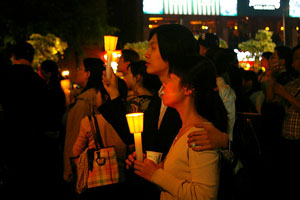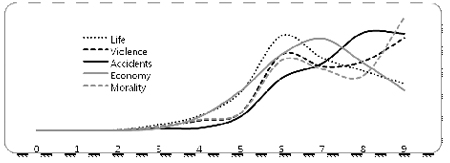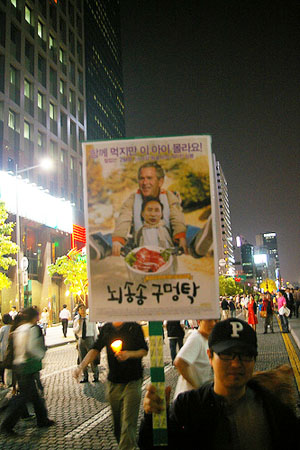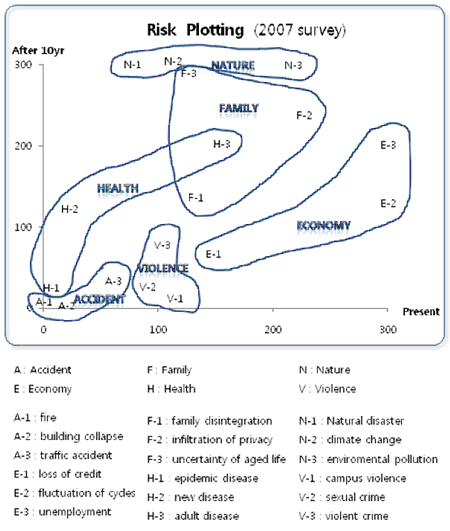Risk Society and Reflexive Modernization in Korea
Han, Sang-Jin *
Recently the Korean politics has been deeply shaken by the nation-wide peaceful candle-light marches by citizens initially launched by the teenage female students of the middle and high schools through the Internet from May to June 2008. The citizens’ ability of expressing and managing their actions in a peaceful way was proven to be highly advanced owing much to a communicative revolution among citizens via the Internet news and the mobile hand-phones. This collective performance was so impressive and suggestive that it had drawn much attention not only domestically but also internationally. The key underlying issue was the social perception of risk society or, more precisely, citizens’ construction of the danger of mad cow disease. Therefore, I would like to review shortly where Korea stands today and how its future looks like in terms of the public perception of risks, and what the idea of reflexive modernization may suggest in this respect.
Survey Research on Risk Society

The nation-wide survey research on risk society goes back to 1999 when 18 items of risks were chosen and clustered into 5 categories. The 18 items were 1) contaminated tap water, 2) poisonous foodstuffs, 3) fraudulent construction, 4) heavy traffic accident, 5) sexual violence and harassment, 6) campus violence, 7) family disintegration, 8) violent crime, 9) unemployment, 10) hostile opposition between labor and management, 11) armed conflict with North Korea, 12) large-scale fire, 13) financial bankruptcy, 14) wire tapping, 15) radioactivity leaking, 16) life negligence, 17) collective egoism, 18) corruption. The 5 clusters included 1) threats to health, 2) violence, 3) accidents, 4) economic disaster, and 5) moral risks. The question was as follows: “Here you find the list of the risks citizens may face these days. How serious do you feel each of these is today?” The suggested answers were ordered from “no serious at all,” “not so serious,” “quite serious,” to “very serious,” and the respondents were asked to choose one of these. The perceived intensity of risks was measured by a scale from 0 to 3 accordingly.
The risk of fraudulent construction was perceived to be most serious, followed by heavy traffic accidents and then by corruption. Despite the financial crisis and unemployment hitting severely Korea that time, the risk of being laid off comes only after corruption, and the risk of banking transaction comes quite behind as Number 14. The risk of armed conflict with North Korea was perceived the lowest. This implies that the popular perception of risks was influenced to a great extent by the collapse of the Han`gang River`s Sŏngsu Bridge (1994) and the Sampoong Department Store (1995) in a middle-class district of Seoul. These incidents shocked the people since nobody thought that this kind of accident could occur.
In particular, corruption was seen as a root cause of many risks citizens faced, for example, fraudulent construction. The collapse of the bridge and department store was seen not simply as a technical failure but as a structural problem in the sense that corruption was deeply embedded in the relationship between government and the private companies. Many construction companies demonstrated their competence to construct technically safe high-quality buildings abroad, but they were prevented from this because of corruption and other institutional constraints and deficiencies.
The comparison by five clusters reveals that risks as accidents were perceived to be most serious in 1999. The moral risks occupied the second top. <Figure 1> shows that despite economic crisis, the perception of economic risks was not as high as that of accidents and moral risks as of 1999.
<Figure 1> perceived seriousness of risks by 5 clusters Number: means; Scale 0-9

The profile analysis showing the actual distribution of responses by each point of scale is also revealing. First, the slope of accident risks looks unusually straightforward compared with that of other clusters. Second, the slopes of life threats and economic risks display a similar pattern. Third, the slopes of violence and moral risks are also distinctive in the sense that those with the utmost urgency increase sharply as we can see in the scale from 8 to 9. In particular, those who felt that the moral risk was of utmost urgency and seriousness sharply increased incomparable to other clusters. Here we can find another aspect of the intensity of risks perceived as of 1999.
<Figure 2> profile distribution of responses by 5 clusters (1999)

The Changing Patterns of Risk Perception from 2007 to 2017
However, the social perception of risks turns out to be quite different when a nation-wide survey was conducted in 2007. This time the items of risks were classified into 6 clusters which include the risks of family, health, environments, violence, accident, and economy. The question asked was not the same as in 1999. But the analysis shows interesting tendencies.
<Figure 3> perceived seriousness of risks by three different timing (2007)

It is unmistakable to find a similar pattern of slope between 10 years ago and present, with the economic risks placed on the top. The cluster of the economic risks is composed of two items, unemployment and the default of credit. Given the widening gap between the rich and the poor, social polarization and economic difficulties of ordinary people, it seems to be quite natural why the respondents have been excessively preoccupied with the economic risks they face in everyday life.

What is interesting in this regard is the anticipated perception of risks 10 years later. Here we find the environmental risks occupying the top quite incomparable to others. The cluster of the environmental risks is composed of the two items of climate change and environmental pollutions.
The second top is the risks about family which is composed of family disintegration and the difficulties of aged life. The

Reflexive Modernization
One step further, we can say that if rush-to modernization has led us to a risk society, we can work out a way out by reflexive modernization. “Reflexive” may have several connotations. The starting point is becoming aware of the dangers of rush-to development. Reflexive means that we draw attention not only to the intended, but also the unintended consequences of the action we take.
The second refers to a more advanced level of reflection where we become aware of the effect of knowledge in creating risks. In other words, we may become more reflexive by taking into consideration how our knowledge, for example, our scientific, medical or biological knowledge, or our identity as men or women is intervening into the construction of reality in such a way that we create more uncertainty and fluidity than fixity and rigidity, thereby giving rise to the perception of risks previously unknown or invisible.
The third refers to a radical openness to ambiguities, uncertainties, and contingencies. Here reflexive means that one admits risks and is ready to live with risks rather than being preoccupied with controlling and eliminating them. Liberated from scientific, technological paradigm, reflexive means taking a deliberative approach with an ironical outlook not to eliminate risks by drawing available scientific, legal, economic resources but to better manage risks. Here, reflexivity has something to do with a radically open way of life.
The fourth level is related to a strategy of development which is conscious of its cultural foundation. Required of this is not just an instrumental but a reflexive approach to policy programs by asking what development or modernization serves for after all. If modernity is bound to produce risk society, we should ask a fundamental question how we can pursue an alternative model of development. Here reflexive means not just to take the West as a model to follow, that is, a catch-up modernization, but to ask the purpose and direction to be taken by reflexive modernization as an alternative and to justify it in terms of culture-based normative standpoints.
With this reflexive perspective, we should pay attention to the increasing gap between the aspect of rapidly proliferating social conflicts and the institutionalized ability of managing conflicts. If we understand modernization as an ongoing process of democratization, Korea has moved successfully along this way since the middle of the 1980's. However, as democratization goes on, more conflicts have tended to arise in various sectors, outpacing the governmental and/or social capability of conflict resolution. Risk here refers to deep division, antagonism, and conflict which separate rather than unite people. Risk arises not because of conflicts as such but because of the increasing disparity between the level where conflicts tend to proliferate and the capacity building of conflict resolution on the part of state and society. Necessary for capacity building is a political leadership that takes long-term responsibility for their action as well as transparence upon which trust on public institutions can be created and fostered. In the past, having only one view in mind, government and business leaders failed to pay due attention to the possible negative repercussions that their preoccupation with rush-to development might bring to society in the long term. Under these circumstances such vital organizations for public policies as the state administration, banks, credit institutes which were supposed to control risks have been found to be immensely involved in creating and spreading them. These deficiencies can and should be drastically improved.
Care must be taken, however, not to fall in a pessimistic determinism. Viewing risks as consequences of rush-to mode of development implies that certain risks can be reduced by formulating better policies and approaches. If we develop a more rational, more flexible, more responsive system of risk management, the institutional capacity of dealing with risks may be significantly strengthened. However, it also implies that it is not easy to radically change the very rush-to mode of development since the prevailing mentality, aspiration, and driving force associated with it have been made already too familiar to many people.
* Professor of Seoul National University




